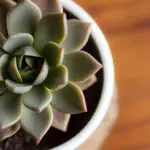Welcome to “The Ultimate Guide to Succulent Care” – your go-to resource for everything you need to know about nurturing these charming desert darlings. Succulents have taken the gardening world by storm, becoming immensely popular in recent years. You can spot them adorning coffee tables, office desks, and even Instagram feeds of plant enthusiasts.
But what makes succulents so irresistible? It’s not just their photogenic leaves and whimsical shapes but also their incredible hardiness and adaptability. These plants are like the superheroes of the botanical world, thriving in the harshest conditions that would make other plants wither away like a bad hair day.
Imagine this: You come home from work one day to find your roommate’s dog chewing on your favorite houseplant. While most plants would simply wilt and die, a succulent would probably just shrug it off and continue to look fabulous. They are like the unruffled James Bond of the plant kingdom.
Let’s face it – we’ve all had our fair share of plant-murdering mishaps. Overwatering, underwatering, neglecting, or giving too much love…you name it, we’ve done it. But with succulents, even the most botanically challenged among us can succeed. That being said, even superheroes need a little bit of guidance sometimes, and that’s why we’re here.
In this comprehensive guide, we’ll reveal the secrets to keeping your succulents happy, healthy, and thriving. Whether you’re a complete succulent newbie or a seasoned plant parent, you’ll find valuable tips, tricks, and practical advice that will help you conquer the world of succulent care.
So, let’s roll up our sleeves, get our hands dirty, and embark on an exciting journey into the enchanting world of succulents. Brace yourself for a greener, less stressful, and unequivocally more badass way of plant parenting. Together, we can conquer the succulent universe!
Choosing the Right Succulents
So, you’ve finally decided to venture into the world of succulent ownership. You’ve seen them pop up all over Instagram and Pinterest, those beautiful little plants with their plump, water-storing leaves. But before you rush off to the nearest garden center or start adding to your online cart, it’s important to consider a few factors that will help you choose the right succulents for your home. Don’t worry, we’ve got you covered!
Consider Your Light Conditions
First and foremost, think about the amount of light your succulents will receive in your space. Succulents are sun-worshippers, and while they can tolerate some shade, they thrive in bright, indirect light. So, take a good look around your home and identify the brightest spots – near a south-facing window or a well-lit kitchen countertop, for instance. Keep in mind that some succulents can handle more direct sunlight than others, so if your space gets scorchingly bright, you’ll want to choose varieties like Echeveria, Jade, or Haworthia that can handle the intensity.
Consider Your Commitment Level
Next, let’s talk about your commitment level to succulent care. We get it, life can get busy, and not all of us have a green thumb. If you’re a beginner or simply prefer low-maintenance plants, we recommend starting with succulents that are forgiving and can tolerate a little neglect. Think about succulents like the Snake Plant (Sansevieria), Zebra Plant (Haworthia fasciata), or the resilient Aloe Vera. These plants are tough cookies and can survive a little forgetfulness when it comes to watering.
On the other hand, if you’re up for a challenge or enjoy giving your plants a bit more attention, there are plenty of other succulents that will reward your efforts. Take the String of Pearls (Senecio rowleyanus), for example. This delicate trailing succulent requires precise watering and loves bright indirect light. Or, if you’re feeling a bit more adventurous, you might try your hand at propagating your succulents – it’s like plant magic!
Consider Your Space and Style
Last but not least, consider your space and personal style when selecting succulents. Succulents come in a wide range of shapes, sizes, and colors, so you can find the perfect match for your home’s aesthetic. If you have a small apartment or limited space, opt for compact succulents like the adorable Echeveria ‘Lola’ or the aptly named Baby Toes (Fenestraria aurantiaca). These pint-sized lovelies will make a big impact in a small space.
If you’re looking to make a statement, go for succulents with unique forms. Consider varieties like the Living Stones (Lithops), which look like tiny pebbles or the Rosette-shaped Hens and Chicks (Sempervivum). These showstoppers have a sculptural quality and are sure to be conversation starters when guests visit.
Remember, choosing the right succulents is all about finding the perfect match for your light conditions, commitment level, and personal style. So, take some time to explore different types and chat with fellow succulent enthusiasts online or at your local garden center. With a little research and a lot of love, you’ll find yourself surrounded by a stunning succulent collection that adds beauty and tranquility to your home. Happy succulent shopping!
Succulent Care Basics
Understanding the needs of your leafy friends
Taking care of succulents doesn’t have to be a prickly thorny experience! With the right knowledge and a touch of green-thumb intuition, you can provide the perfect environment for these trendy, easy-to-maintain plants. Let’s delve into the essential steps of succulent care, from sunlight to watering, soil, and temperature requirements.
Soaking up the sun
Picture this: your succulent sunbathing on a bright windowsill, soaking in those glorious rays. Succulents thrive in sunlight, but just like humans, they can also suffer from sunburns. To strike the right balance, make sure your succulents get around 6 hours of bright, indirect light per day. However, keep an eye on those delicate leaves – if they start turning yellow or brown, it’s a sign they’re getting too much direct sunlight. Give them a little shade break!
Quenching their thirst responsibly
When it comes to succulent watering, the golden rule is “less is more.” These water-saving champs don’t appreciate soggy roots but are still living beings that need hydration. Give your succulents a good drink once their soil has fully dried out. But how do you figure that out? Stick your finger about an inch into the soil and check if it feels dry. If it’s still a bit moist, hold back on the watering can for a little longer. Remember, succulents are survivors, so don’t fret if you occasionally forget to water them. They’ll appreciate the occasional drought-style vacation!
Getting down and dirty with soil
Just like cats have preferences for certain types of litter, succulents have their soil preferences too! They thrive in well-draining soil that’s designed to prevent water from pooling around their roots. One popular option is a mix of equal parts succulent or cactus soil and perlite, which adds extra drainage. This helps prevent your green buddies from suffering from dreaded root rot. So, when planting or replanting your succulents, don’t shy away from getting a little dirty and giving them the ideal soil environment.
Keeping it cool, but not frosty
You might think succulents are sturdy enough to handle temperature extremes, but even these resilient plants have their limits. They generally prefer temperatures between 60°F and 85°F (15°C – 29°C). However, some species of succulents, like the popular Echeverias, can tolerate slightly cooler temperatures. Just beware of frost – succulents aren’t big fans of being Frozen impersonators. If the mercury drops too low, it’s better to bring them indoors temporarily or cover them with a frost cloth. Remember, Jack Frost may be fun for snowmen, but not for succulents!
Remember, each succulent has its own unique care requirements, so always do a bit of research to ensure you’re meeting their individual needs. By following these basic care steps, your succulents will flourish and become the envy of all your plant-loving friends. So, go ahead and show those succulents some T.L.C. – Tender Loving Care!
Propagating Succulents Care: Methods and Tips for Expanding Your Collection
So, you’ve fallen in love with succulents and now you want to expand your collection. The good news is, propagating succulents is not only a fun and rewarding experience, but it’s also a great way to grow your collection without spending a fortune. In this section, we’ll explore different methods and offer some handy tips to help you successfully propagate your succulents.
Leaf Propagation: A Miracle of Nature
One of the most common and fascinating methods of succulent propagation is leaf propagation. Simply put, it involves plucking a healthy leaf from the parent plant and allowing it to form new roots and eventually grow into a mini replica of its parent.
Here’s a real-life example: Imagine you have a stunning Echeveria ‘Lola’ in your collection, and you want more of this beauty. Carefully remove a healthy, firm leaf from the base of the plant and let it dry for a few days until it develops calluses. Place the leaf on top of well-draining soil, making sure it has good contact, and mist it lightly every few days. After a few weeks, you’ll notice tiny roots emerging from the leaf, and eventually, a tiny new rosette will form. Voila! You’ve successfully propagated your Echeveria ‘Lola’.
Stem Cuttings: A Shortcut to Success
If you’re impatient and eager to see results, stem cuttings are the way to go. This method involves snipping off a healthy stem from the parent plant and allowing it to develop roots and become a new plant on its own. It’s like giving nature a helpful nudge.
Let’s say you have a magnificent Graptopetalum paraguayense in your collection, and you want more of its vibrant rosettes. Take a sharp, clean pair of scissors or pruning shears and cut a 4-6 inch stem from the parent plant. Remove the bottom few leaves, exposing the nodes, and let the cutting dry for a day or two. Once the cut end has callused over, place it in well-draining soil and water sparingly. Before you know it, roots will start to develop, and a new plant will emerge, ready to adorn your succulent collection.
New Growth Offsets: Cloning in Action
Many succulents, such as Aloe vera, produce offsets, or “pups,” which are the tiny clones of the parent plant. These little babies can be easily separated and grown into independent plants, giving you a free and effortless way to expand your collection.
Imagine you have a beautiful Haworthia attenuata with several offsets growing around its base. Gently twist or cut the offsets away from the parent plant, making sure each has its own roots or at least a callused end. Allow them to dry for a day or two, just like with stem cuttings, and then plant them in their individual pots with well-draining soil. With a little care, these clones will thrive and become new additions to your mesmerizing succulent family.
Remember, the key to successful succulent propagation is patience, attention, and following the proper techniques for each method. But with a little practice, you’ll soon find yourself with an ever-expanding collection of unique and beautiful succulents, all grown from your own green thumbs! Happy propagating!
Common Mistakes to Avoid for succulent care
So, you’ve brought home a lovely succulent to add some greenery to your space. Congrats! Succulents are not only trendy but also super easy to care for. However, it’s important to be aware of some common pitfalls that could lead to the demise of your new green friend. In this section, we’ll discuss a few missteps that many succulent enthusiasts make, so you can avoid them and keep your succulent thriving.
Avoid Overwatering
One of the most common mistakes people make when caring for succulents is overwatering. These little beauties don’t need as much water as you might think. In fact, succulents are native to arid regions and have adapted to survive in dry conditions.
Imagine you’re at the beach on a scorching summer day. You’ve been lying under the sun all day and are desperately thirsty. If someone poured a bucket of water on your head, you might drown, right? Well, succulents feel the same way when they’re overwatered. Their roots become waterlogged, leading to rot, root diseases, and ultimately, the death of the plant.
Master Potting Techniques
Potting your succulent correctly is crucial in ensuring its survival. A common mistake is using the wrong type of soil. Avoid heavy, moisture-retaining soils like garden soil or regular potting soil. Instead, opt for a well-draining succulent or cactus mix, which you can easily find at your local garden center or online. This type of soil allows excess water to quickly pass through, preventing root rot.
Another potting error to avoid is choosing a container without proper drainage. Just imagine living in a house with no windows or doors – it would be suffocating! Well, succulents feel the same way when they’re confined to a container without drainage holes. Water gets trapped, and the roots suffocate. So, be sure your pot has adequate drainage to keep your succulent happy and healthy.
Moderate Sun Exposure
While succulents love sunlight, too much of a good thing can be harmful. Overexposure to intense sunlight can scorch the leaves or even turn them fully sunburned, like a regrettable beach tan. On the other hand, insufficient sunlight can cause succulents to stretch or become etiolated, as they desperately reach for light like a plant version of Leonardo DiCaprio reaching for an Oscar. Both scenarios can lead to a weakened and unhappy succulent.
So, find a balance. Choose a spot near a sunny window or provide filtered sunlight for a few hours a day. Monitor your succulent’s response and adjust accordingly to ensure it thrives.
Keep an Eye on Pests
Succulents, like all plants, can fall victim to pesky pests. Whether it’s tiny spider mites creating web fortresses or mealybugs feasting on their succulent buffet, these intruders can wreak havoc on your plants. Keep a watchful eye for any signs of infestation, such as sticky residue, discolored or distorted leaves, or small crawling creatures.
If you detect any unwanted visitors, fear not! You can combat them using non-toxic methods like wiping the leaves with a mixture of water and mild soap or using organic pest control products available in stores. By staying vigilant, you can keep your succulent free from these little invaders and ensure its longevity.
Avoiding these common mistakes will set you on the path to succulent success. Remember, while caring for succulents is relatively easy, they still have specific needs that must be met for optimum growth. By understanding their preferences and avoiding these pitfalls, you’ll be well on your way to becoming a succulent care guru!
Dealing with Common Pests and Problems
One of the key challenges you may encounter when caring for succulents is dealing with common pests and diseases. Trust me, these little critters can be quite the nuisance, but with a little know-how, you can keep your succulents thriving and pest-free.
Identifying pests can be tricky, as they are often small and camouflaged. However, keeping a close eye on your succulents can help you catch them early. Let’s take a look at some common pests and how to deal with them:
- Mealybugs: These tiny, cotton-like insects love to hide in the nooks and crannies of your succulents. If you spot a white, powdery substance on your plants or notice some sticky residue, chances are you have mealybugs. To get rid of them, dab a cotton swab dipped in rubbing alcohol on the affected areas. Remember to isolate infected plants to prevent the bugs from spreading.
- Spider Mites: These arachnids are so small that they can be difficult to spot with the naked eye. However, if you notice tiny webs appearing on your succulents or see small yellow or white spots on the leaves, it’s a clear sign of spider mite infestation. You can blast them away with a strong stream of water or use an insecticidal soap to control their population.
- Aphids: These little sap-suckers can quickly multiply and wreak havoc on your succulents. If you notice misshapen leaves, sticky residue, or black sooty mold, aphids might be the culprits. A gentle spray of soapy water can help remove them. For a natural approach, you can also introduce ladybugs to your garden as they feast on aphids.
Now, let’s talk about some common diseases that can affect succulents and how to combat them:
- Root Rot: Overwatering is often the main culprit behind root rot in succulents. If you notice your succulent’s leaves becoming mushy and discolored, it’s a sign that the roots are rotting. To save your plant, carefully remove it from the soil, trim off any rotten roots, and let it dry out before replanting in a well-draining potting mix.
- Powdery Mildew: This fungal infection appears as a powdery white or gray substance on the leaves of your succulents. To tackle this problem, remove the infected leaves and ensure good air circulation around your plants. Applying a solution of milk and water can also help prevent the spread of powdery mildew.
By being vigilant and proactive in identifying and treating these common pests and diseases, you can keep your succulents in top shape. Remember, prevention is key, so make sure to provide your succulents with the ideal growing conditions and avoid overwatering. With a little care and attention, you’ll have a thriving succulent garden that pests and diseases can’t wreck.
Decorating with Succulents
When it comes to home decor, succulents are a fantastic choice. Not only are they low-maintenance and resilient plants, but they also add a touch of greenery and charm to any space. Whether you have a modern apartment or a bohemian-inspired home, incorporating succulents into your decor can elevate the ambiance and create a unique visual appeal. Here are some creative ideas to help you showcase the beauty of succulents in your home:
Succulent Centerpieces
One of the easiest and most eye-catching ways to incorporate succulents into your home decor is by creating succulent centerpieces. These mini gardens can be placed on your dining table, coffee table, or even on a window sill. Start by selecting a shallow container or tray and fill it with well-draining soil. Then, arrange a variety of succulents with different heights, colors, and textures to create a stunning visual display. You can also add elements like decorative rocks or pebbles to enhance the overall design. Not only will your succulent centerpiece become an instant conversation starter, but it will also thrive with minimal care.
Hanging Succulent Wall
If you’re looking to make a bold statement, consider creating a hanging succulent wall. This unique decor idea adds a touch of whimsy and brings life to any blank wall in your home. To get started, you’ll need a wooden frame with wire mesh backing. Secure the mesh firmly, creating small pockets to hold the succulents. Fill these pockets with well-draining soil and insert small succulent cuttings or plants. Ensure the frame is securely fastened to the wall, and watch as your living artwork grows over time. The best part is that this living wall not only adds visual interest but also purifies the air in your home.
Succulent Terrariums
A succulent terrarium is a miniature garden enclosed in a glass vessel, making it a perfect addition to any indoor space. Start by selecting a clear glass container with a wide opening. Layer the bottom with rocks or pebbles to facilitate drainage. Then, add a thin layer of activated charcoal to prevent odors and keep the soil fresh. Fill the container with cactus or succulent soil, leaving enough space for the plants. Carefully arrange a variety of succulents, making sure they have enough room to grow. Add some decorative elements like small figurines or colorful moss to complete the look. Place your terrarium in a well-lit area, making sure to avoid direct sunlight, and watch your miniature oasis thrive.
By incorporating succulents into your home decor, you not only bring a touch of nature indoors but also create a unique and visually appealing space. Whether it’s through a stunning succulent centerpiece, a hanging succulent wall, or a charming terrarium, these creative ideas will transform your home into a sanctuary of beauty and serenity. Let your imagination run wild and experiment with different placements and arrangements. The possibilities are endless when it comes to decorating with these versatile and captivating plants.
Frequently Asked Questions
1. How often should I water my succulents for the best succulent care?
Watering your succulents can be a bit tricky since they have different water needs compared to other plants. As a general rule, it’s best to water them deeply, but infrequently. Instead of sticking to a strict watering schedule, it’s better to check the moisture level of the soil. Stick your finger about an inch into the soil, and if it feels dry, then it’s time to water. Remember, overwatering is one of the most common mistakes people make, so be cautious not to drown your poor succulents!
For example: Imagine you have a lovely Echeveria on your windowsill. This fleshy succulent has thick, plump leaves that store water, so it doesn’t need frequent watering. If you water it every day, those leaves will become mushy and sad, and your Echeveria may not survive. So, always keep an eye on the soil moisture and adjust your watering accordingly.
2. How do I prune my succulents?
Pruning your succulents is essential to maintain their shape and encourage healthier growth. Start by identifying any dead or shriveled leaves or stems – these are the areas you’ll want to trim. Using sharp and sterilized pruning shears or scissors, carefully remove the unwanted parts, making sure to cut close to the base without damaging the healthy parts.
Consider this scenario: Let’s say you have a vibrant Aloe Vera plant, but it’s starting to look a bit leggy with its lower leaves becoming sparse. Pruning can help rejuvenate it. By snipping off the taller stems and removing the lower leaves that are drooping or browning, you can give it a cleaner and more compact appearance. Plus, the energy of the plant will be redirected to new growth, making it look fresher and more robust.
3. What are the signs of distress in succulents?
Succulents are fairly low-maintenance plants, but they can still show signs of stress if their needs aren’t met. One common sign is wrinkled or shriveled leaves, indicating underwatering. Overwatering, on the other hand, can lead to leaves becoming mushy, translucent, or even falling off the plant. Sunburned leaves often appear brown or yellow and can become mushy if left untreated. Additionally, pests like mealybugs or scale insects may infest your succulents, causing discoloration or a sticky residue.
Imagine this unfortunate situation: Your adorable Echeveria starts to show signs of distress when its leaves start puckering and looking deflated. This is a sign that it needs more hydration! By adjusting your watering routine and giving it a good soak, those leaves will plump up again, and your Echeveria will regain its former glory.
Remember, every succulent is different and may exhibit distress signals in its own unique way. By observing your plants closely and providing the care they require, you’ll keep them happy and thriving.
Now that you have a better understanding of some common questions and concerns about succulent care, you’re well-prepared to nurture your succulents and watch them flourish!



